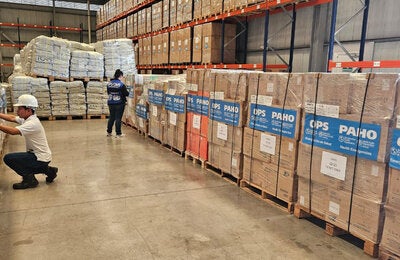After facing stagnating adolescent pregnancy rates, the Dominican Republic is applying a new approach that focuses on equity to make sure no adolescents - including those most at risk of becoming pregnant - are left out of programs designed to prevent teen pregnancy.
This new approach comes as a response to the new global health agenda, which centers on equity and universality and prioritizes the health and well-being of adolescents and includes specific indicators and targets related to adolescent pregnancy.
Adolescent pregnancy remains high in the Region
Some progress has been made to prevent adolescent pregnancy in the Latin American and the Caribbean (LAC) region, but there are subpopulations where it remains high. Indigenous, rural, less educated and adolescents from lower wealth index quintiles are more likely to become pregnant, compared with their counterparts who are nonindigenous, urban, more educated and in higher wealth index quintiles. For instance, 15% of adolescents in the lowest quintile of the income distribution are mothers, compared with 4% of adolescents in the highest income quintile.
In the Dominican Republic, there are approximately 2 million adolescents between the ages 10-19, constituting 19% of the country's total population. The current adolescent fertility rate of 96 births per 1000 women aged 15-19 is the highest in LAC. Available data indicates that 22% of women between 12-19 years have been pregnant, which is 34% higher than the average for LAC.
The stagnating adolescent pregnancy rate and its inequal distribution in the population threaten national gains in development and put at risk the possible achievement of the targets and goals set for 2030.
Reviewing national programs to reduce adolescent pregnancy
In mid-2017, the Ministry of Health in the Dominican Republic, together with PAHO, brought together a multi-sectoral committee to revise the National Plan for the Prevention of Adolescent Pregnancy 2011-2016, using Innov8, an equity-based methodology that allows for the evaluation and re-design of national plans, strategies and/or programs, to close gaps and leave no one behind.
Specifically, Innov8 focuses on:
- Identifying the groups being left behind by current health plans, strategies and/or programs
- Examining the barriers and facilitating factors to effective coverage of the plans, strategies and/or programs
- Understanding the social structural and social intermediary determinants that generate social inequities in health
- Establishing intersectoral action and the degree of social participation to reduce inequities and ensure no one is left out
- Measuring and monitoring progress using an equity lens
The Innov8 methodology was taught in a preliminary work shop in August 2017. Twenty participants from different sectors who participated throughout the process have learned to apply the methodology and can use it for future reviews and reformulation processes of other plans, programs or strategies with a gender, human rights and equity-based perspective.
Current work with Innov8 in the Dominican Republic
The review team, consisting of personnel working in different sectors and institutions - as well as adolescents themselves - is currently completing the eight steps of Innov8. They have produced evidence-based recommendations for the formulation of the new national plan to prevent adolescent pregnancy so it will reach the population groups that are currently being left behind. By reaching these groups, the country will be able to break the stagnating adolescent pregnancy rates.
In August 2018, the national comittee for prevention of adolescent pregnancy will present their recommendations to the Social Cabinet of the Vice-Presidency, who will use these recommendations and others from an external evaluation to start formulating a new quinquennial plan. In collaboration with the social Cabinet of the Vice-Presidency, the final step of the Innov8 process of creating a robust monitoring and evaluation system for the new plan will be completed once the new plan has taken shape.
The Innov8 review process has allowed the National multi-sectoral committee to work together on a regular basis during the past months. This dynamic and critical collaboration effort lead to a strong technical alliance with inclusion of adolescents who participated during the process. It promoted the sharing of all published and unpublished resources created during the past seven years in the country and recognition of success stories.
Investing in adolescents
Adolescents are the greatest resource for a society to thrive and transform. Investing in adolescents brings a triple benefit:
- Ensures healthy adolescents in the present;
- Ensures healthy adults in the future; and
- Produces healthy future generations.
Preventing adolescent pregnancy is key to lowering preventable deaths among adolescent girls and making sure they can develop to their full potential.
References
UNFPA. Regional Population Report in Latin America and the Caribbean 2011: Investing in Youth. Retrieved 27 April 2018 from: http://www.cepal.org/publicaciones/xml/8/47318/Informejuventud2011.pdf.
World Bank. (2018). Adolescent Fertility Rate. Retrieved 6 April 2018 from: https://data.worldbank.org/indicator/SP.ADO.TFRT?year_high_desc=false
UNDP. (2017). The Pregnancy In Adolescents: A Multidimensional Challenge To Generate Opportunities In The Life Cycle. Santo Domingo: UNDP. Retrieved 216 April 2018 from: http://www.do.undp.org/content/dominican_republic/es/home/library/human_development/informe-nacional-de-desarrollo-humano-2017---embarazo-adolescent/



